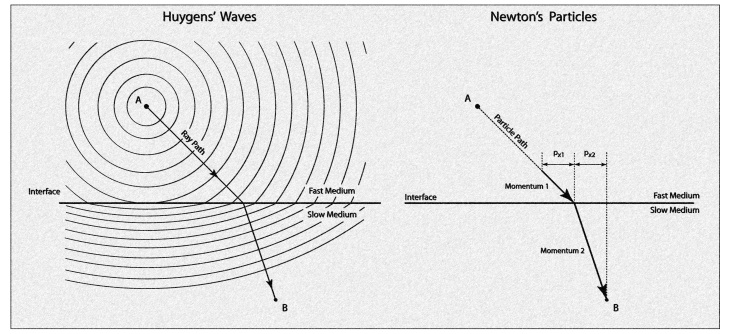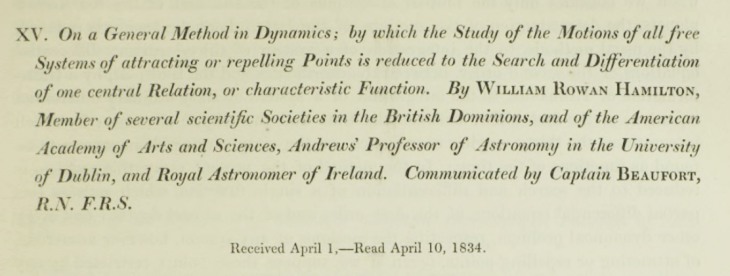Wave-particle duality was one of the greatest early challenges to quantum physics, partially clarified by Bohr’s Principle of Complementarity, but never easily grasped even today. Yet long before Einstein proposed the indivisible quantum of light (later to be called the photon by the chemist Gilbert Lewis), wave-particle duality was firmly embedded in the foundations of the classical physics of mechanics.
Light led the way to mechanics more than once in the history of physics.
Willebrord Snel van Royen
The Dutch physicist Willebrord Snel van Royen in 1621 derived an accurate mathematical description of the refraction of beams of light at a material interface in terms of sine functions, but he did not publish. Fifteen years later, as Descartes was looking for an example to illustrate his new method of analytic geometry, he discovered the same law, unaware of Snel’s prior work. In France the law is known as the Law of Descartes. In the Netherlands (and much of the rest of the world) it is known as Snell’s Law. Both Snell and Descartes based their work on Newton’s corpuscles of light. The brilliant Fermat adopted corpuscles when he developed his principle of least time to explain the law of Descartes in 1662. Yet Fermat was forced to assume that the corpuscles traveled slower in the denser material even though it was generally accepted that light should travel faster in denser media, just as sound did. Seventy-five years later, Maupertuis continued the tradition when he developed his principle of least action and applied it to light corpuscles traveling faster through denser media, just as Descartes had prescribed.

The wave view of Snell’s Law (on the left). The source resides in the medium with higher speed. As the wave fronts impinge on the interface to a medium with lower speed, the wave fronts in the slower medium flatten out, causing the ray perpendicular to the wave fronts to tilt downwards. The particle view of Snell’s Law (on the right). The momentum of the particle in the second medium is larger than in the first, but the transverse components of the momentum (the x-components) are conserved, causing a tilt downwards of the particle’s direction as it crosses the interface. [i]
Young Hamilton
William Rowland Hamilton (1805—1865) was a prodigy as a boy who knew parts of thirteen languages by the time he was thirteen years old. These were Greek, Latin, Hebrew, Syriac, Persian, Arabic, Sanskrit, Hindoostanee, Malay, French, Italian, Spanish, and German. In 1823 he entered Trinity College of Dublin University to study science. In his second and third years, he won the University’s top prizes for Greek and for mathematical physics, a run which may have extended to his fourth year—but he was offered the position of Andrew’s Professor of Astronomy at Dublin and Royal Astronomer of Ireland—not to be turned down at the early age of 21.

Title of Hamilton’s first paper on his characteristic function as a new method that applied his theory from optics to the theory of mechanics, including Lagrangian mechanics as a special case.
His research into mathematical physics concentrated on the theory of rays of light. Augustin-Jean Fresnel (1788—1827) had recently passed away, leaving behind a wave theory of light that provided a starting point for many effects in optical science, but which lacked broader generality. Hamilton developed a rigorous mathematical framework that could be applied to optical phenomena of the most general nature. This led to his theory of the Characteristic Function, based on principles of the variational calculus of Euler and Lagrange, that predicted the refraction of rays of light, like trajectories, as they passed through different media or across boundaries. In 1832 Hamilton predicted a phenomenon called conical refraction, which would cause a single ray of light entering a biaxial crystal to refract into a luminous cone.
Mathematical physics of that day typically followed experimental science. There were so many observed phenomena in so many fields that demanded explanation, that the general task of the mathematical physicist was to explain phenomena using basic principles followed by mathematical analysis. It was rare for the process to work the other way, for a theorist to predict a phenomenon never before observed. Today we take this as very normal. Einstein’s fame was primed by his prediction of the bending of light by gravity—but only after the observation of the effect by Eddington four years later was Einstein thrust onto the world stage. The same thing happened to Hamilton when his friend Humphrey Lloyd observed conical refraction, just as Hamilton had predicted. After that, Hamilton was revered as one of the most ingenious scientists of his day.
Following the success of conical refraction, Hamilton turned from optics to pursue a striking correspondence he had noted in his Characteristic Function that applied to mechanical trajectories as well as it did to rays of light. In 1834 and 1835 he published two papers On a General Method in Mechanics( I and II)[ii], in which he reworked the theory of Lagrange by beginning with the principle of varying action, which is now known as Hamilton’s Principle. Hamilton’s principle is related to Maupertuis’ principle of least action, but it was more rigorous and a more general approach to derive the Euler-Lagrange equations. Hamilton’s Principal Function allowed the trajectories of particles to be calculated in complicated situations that were challenging for a direct solution by Lagrange’s equations.
The importance that these two papers had on the future development of physics would not be clear until 1842 when Carl Gustav Jacob Jacobi helped to interpret them and augment them, turning them into a methodology for solving dynamical problems. Today, the Hamiltonian approach to dynamics is central to all of physics, and thousands of physicists around the world mention his name every day, possibly more often than they mention Einstein’s.
[i] Reprinted from D. D. Nolte, Galileo Unbound: A Path Across Life, the Universe and Everything (Oxford, 2018)
[ii] W. R. Hamilton, “On a general method in dynamics I,” Phil. Trans. Roy. Soc., pp. 247-308, 1834; W. R. Hamilton, “On a general method in dynamics II,” Phil. Trans. Roy. Soc., pp. 95-144, 1835.

[…] Wave-Particle Duality and Hamilton’s Physics […]
LikeLike
[…] Wave-Particle Duality and Hamilton’s Physics […]
LikeLike
[…] Wave-Particle Duality and Hamilton’s Physics […]
LikeLike
[…] Wave-Particle Duality and Hamilton’s Physics […]
LikeLike
[…] Wave-Particle Duality and Hamilton’s Physics […]
LikeLike
[…] Wave-Particle Duality and Hamilton’s Physics […]
LikeLike
[…] Wave-Particle Duality and Hamilton’s Physics […]
LikeLike